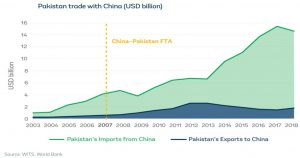|Shahid Sattar and Eman Ahmed
Free trade agreements (FTAs) regulate trade by waiving off certain duties, taxes, and tariffs, aiming to reap maximum benefits from both countries’ comparative advantage positions. However, these agreements need to be effectively leveraged to enable market access and export-led economic growth and to maintain a sustainable trade balance.
The anti-export bias of Pakistan’s trade policy has made it difficult for expansion-oriented industries to grow by accessing global markets and has also discouraged foreign firms from investing in Pakistan.
As a result, Pakistan’s exports have remained stagnant, lacking diversification and sophistication.
Read more: Finding Pakistan’s missing exports
The untapped Chinese market
Despite its immense potential, the Pakistan–China free trade agreement (FTA) has had only a modest impact on bilateral trade.
The first phase of the FTA did not successfully steer export diversification as expected, given that the products that accounted for this increase were primarily exports of cotton yarn, linens, and leather.

Key Pakistani exports have remained at partial or no concessions under the FTA-I. While China has granted concessions on tariff lines amounting to 83 percent of export volume, about 70 percent of exports are in tariff lines at less than 50 percent or no concession.
Despite China granting concessions to 72 percent of Pakistan’s exports, findings show there is considerable export potential that could still be explored. Only 30 percent of Chinese tariffs under the agreement have been fully liberalized. Important Pakistani exports receiving no or only partial concessions under the FTA include cotton yarn (with greater than 85 percent cotton), semi-milled or wholly milled rice, leather further prepared after tanning or crusting, and fresh or dried nuts. In sum, the China–Pakistan Free Trade Agreement has room for expansion in both sectoral scope and depth of commitments.
Read more: China Pakistan Free Trade Agreement Opening bigger and brighter opportunities
Phase-II of the CPFTA intends to deepen trade relations between China and Pakistan through increased liberalization of trade, safeguarding mechanisms for domestic industry, and facilitating the intercountry balance of payments and electronic data exchange.
Other free trade agreements
Pakistan has as such signed FTAs with China, Sri Lanka, and Malaysia; while enjoying preferential trade agreements (PTAs) with Iran, Indonesia, and Mauritius. Pakistan is also part of the South Asia Free Trade Agreement (SAFTA) under the auspices of the South Asian Association for Regional Cooperation (SAARC) and has a Transit-trade agreement with neighboring Afghanistan.
Pakistan has now also signed a transit-trade agreement with Uzbekistan, finalizing a preferential trade agreement (PTA) within three months to boost bilateral trade volume and opening the gate for trade with Central Asian Republics.
https://twitter.com/APTMAofficial/status/1415651109537001473?s=20
Both countries, expressing satisfaction at the continued progress in bilateral relations, announced the establishment of a strategic partnership for their mutual benefit. The parties have agreed to deepen partnership in industrial cooperation, by organizing joint ventures in the field of the textile industry, assembly of agricultural machinery, and processing and packaging of fruit and vegetable products.
Read more: Pakistan, Uzbekistan to jointly produce film on Mughal Emperor Babar
Preferential trade agreements have an instrumental role to play in the trade development of Pakistan. With Iran, Pakistan’s volume of trade is not that high due to sanctions against Iran, but there remains immense potential for exports and barter trade. This trade can be enhanced by removing tariffs and non-tariff barriers. The same applies to Turkey, where cooperation is already underway to enhance trade in merchandise.
US-Pakistan trade
Pakistan does not have an FTA with the US, and this is a considerable handicap in the country’s trade dynamics relative to regional players like Bangladesh, for whom the US serves as the most important trading partner.
The 2003 US-Pakistan Trade and Investment Framework Agreement (TIFA) was intended to create jobs through economic growth by enhancing investment in various sectors of economy. The objective of this agreement was to expand bilateral trade and investment in goods and services.
The growth model through this framework was envisaged to enhance digital trade, improve the business climate, strengthening intellectual property rights as well as aiming at women empowerment, labor reforms, and skill development for workers.
Read more: Huge investment doors to open for Pakistan by 2023
The US is one of the largest markets for Pakistani goods and services, so it could possibly be the main destination for Pakistani products to enjoy truly international exposure. At present, the Pak-US trade volume is in excess of $7 billion.
Impact of trade reforms
The advantages of FTAs are rooted in the enhanced competition that they enable. This competition creates efficiencies and strengthens exports, resulting in overall economic growth and development.
With trade barriers out of the way, manufacturers compete directly, and market forces incentivize them to become increasingly efficient and capture more market share to earn profits.
The World Bank Group has evaluated the potential economic impacts of three types of trade reform scenarios in Pakistan:
- Unilateral liberalization of tariffs and other charges on imports,
- Liberalization of Non-tariff measures (NTMs)
- Improvements in trade facilitation
The unilateral tariff liberalization scenario will require certain measures such as imposing a maximum limit of 5 percent on customs duty, which could result in a 4.2 percent increase in imports and a 12.8 percent decline in tax revenues from imports. In the medium to long term, imports could increase by 5.7 percent, exports by 10.2 percent, and GDP by 0.5 percent.
Read more: Pakistan’s trade deficit increases 20.05pc as imports rise in March
In the long term, these increases would exceed the short-term loss in tax revenue. Elimination of non-FTA import duty suspension and refund programs imposing zero customs duties for raw materials, intermediates, and capital goods would mitigate the anti-export bias and revitalize trade in Pakistan.
Improved access to higher-quality inputs must be ensured through tariff reductions on textiles and an improved Duty & Tax Remission for Exporters (DTRE) program.
Others in the region are leading in this respect: Sri Lanka has eliminated all import tariffs on textiles to improve competitiveness in the apparel industry, while Bangladesh’s Special Bonded Warehouse Scheme (SBWS) provides rapid, duty-free access to all imported inputs for all exporters in all sectors of the Bangladesh economy. The scheme has some 4,500 licensed users, and textiles and apparel manufacturers in Bangladesh attribute their success largely to the SBWS arrangement.
The focus of modern FTAs has shifted dramatically from the traditional emphasis on market access to other measures such as services, investment, competition policy, intellectual property rights, government procurement, state trading enterprises, labor, environment etc.
Read more: AWT Investments Set to Transform Pakistan’s Investment landscape
The cross-cutting reforms required to improve overall competitiveness include taking advantage of the high-value-added apparel, providing local apparel exporters with access to higher-quality inputs – including synthetic fibres – at world prices, and sustainable import duty suspension/removal, and effective refund programs/exemptions on Sales Tax for textiles and other apparel inputs.
The National Export Development Board (NEDB), was recently constituted to act as a monitoring tool for government policies to enhance exports and provide strategic guidance to the government to enhance the exports, review the implementation and progress of the country’s trade policy. It is hoped that the suggested reforms will be taken into account for expected results in trade liberalization and benefits for the economy as a whole.
The tariff structure offered to Pakistan under Phase-II is a marked improvement over Phase-I. Reduced tariffs, wider market access, new safeguard measures to protect domestic industry are some salient features of the amendment.
Mr. Shahid Sattar, now Executive Director & Secretary General of All Pakistan Textile Mills
Association (APTMA), has previously served as Member Planning Commission of Pakistan and an advisor to the Ministry of Finance, Ministry of Petroleum, Ministry of Water & Power. Eman Ahmed is a Research Analyst at APTMA. The views expressed by the writers do not necessarily represent Global Village Space’s editorial policy.














